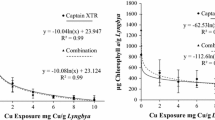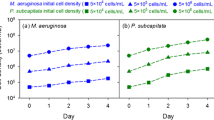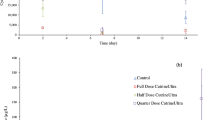Abstract
Laboratory studies of algicide toxicity to algal species provide information to improve the efficacy and efficiency of copper-containing algicides in actual field situations. The objectives of this study were (1) to measure the influence of copper form, initial concentration, and duration of exposure on the response of Raphidocelis subcapitata, a planktonic freshwater green alga; (2) to determine the contact time required for these copper-containing algicides (Clearigate®, Cutrine®-Plus, and copper sulfate) and the target species to obtain control; (3) to measure the critical burden of the three algicides required to obtain control of R. subcapitata; (4) to measure the residence time of the copper applied as the algicides in the water column of three waters having different water characteristics (i.e., alkalinity, hardness, pH, and conductivity); and (5) to contrast exposures of copper (as algicides) required to control algae and the lower thresholds causing adverse effects on sensitive nontarget animal species. Algal control (EC100) was accomplished at 55.8, 117.5, and 187.5 μg Cu/L for CuSO4, Cutrine-Plus and Clearigate with a contact time of 3 days in all cases. The critical burdens of copper (concentration sorbed by the algae) were 4.2, 7.3, and 7.9 μg Cu/mg algae (dry weight) for CuSO4, Cutrine-Plus, and Clearigate, respectively. Because algicide toxicity generally decreases as cell density increases, the density of cells in algal blooms may hamper algicide effectiveness even at maximum label application rates. Determinations of critical burdens for algicides and target algal species provide necessary information to forecast the performance of algicide applications in field situations. The margin of safety (i.e., the difference between the concentration where control of algae was obtained and the lower threshold concentration causing adverse effects on nontarget species) was greatest for Cutrine-Plus. However, the margins of safety are minimal (< 0, 12.5, and 82.5 μg Cu/L for Ceriodaphnia dubia exposed to CuSO4, Clearigate, and Cutrine-Plus, respectively) when they are applied according to their labels.
Similar content being viewed by others
Author information
Authors and Affiliations
Additional information
Received: 21 August 2001/Accepted: 4 February 2002
Rights and permissions
About this article
Cite this article
Murray-Gulde, C., Heatley, J., Schwartzman, A. et al. Algicidal Effectiveness of Clearigate, Cutrine-Plus, and Copper Sulfate and Margins of Safety Associated with Their Use. Arch. Environ. Contam. Toxicol. 43, 19–27 (2002). https://doi.org/10.1007/s00244-002-1135-1
Issue Date:
DOI: https://doi.org/10.1007/s00244-002-1135-1




